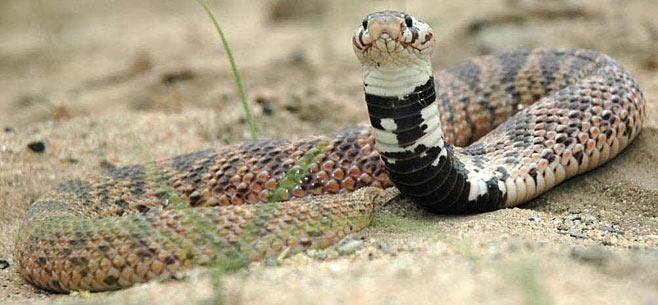|
Aspidelaps scutatus (Shield-nose snake)
Skildneusslang [Afrikaans]
Life >
Eukaryotes
>
Opisthokonta >
Metazoa
(animals) > Bilateria > Deuterostomia >
Chordata >
Craniata > Vertebrata (vertebrates) > Gnathostomata (jawed vertebrates) >
Teleostomi (teleost fish) > Osteichthyes (bony fish) > Class:
Sarcopterygii (lobe-finned fish) > Stegocephalia (terrestrial vertebrates) >
Tetrapoda
(four-legged vertebrates) > Reptiliomorpha > Amniota >
Reptilia (reptiles) >
Romeriida > Diapsida > Lepidosauromorpha > Lepidosauria >
Squamata > Serpentes
(snakes) > Family: Elapidae > Genus:
Aspidelaps
 |
|
Aspidelaps scutatus scutatus (Speckled
sheld-nose snake), Mozambique. [photo I.C. and A. Sharp ©, from
SARCA
Virtual Museum] |
 |
|
Aspidelaps scutatus intermedius (Intermediate
shield-nose snake), Mpumalanga. [photo I.C. and A. Sharp ©, from
SARCA
Virtual Museum] |
Identification
The Shield-nose snake can be identified by the following
features and behaviors; its short thick body, a single large nasal scale, its
cobra like ability to lift its head of the ground (it does however not spread a
hood), its habit of playing dead when threatened and its strictly nocturnal way
of life. It grows to an average length of 45 cm but may reach 75 cm in length.
Distribution and habitat
Distribution of the three recognised subspecies is as
follows:
- Aspidelaps scutatus scutatus (Speckled shield-nose
snake): Northern Namibia, Botswana, western Zimbabwe, Limpopo.
- Aspidelaps scutatus intermedius (Intermediate
shield-nose snake): Mpumalanga
- Aspidelaps scutatus fulafulus: south-eastern Zimbabwe and
southern Mozambique
Food
Feeds on
amphibians, small
mammals, lizards and other snakes.
Predators, parasites and disease
Eaten by other snakes.
Reproduction
Oviparous lays between 4 and 14 eggs in summer and is known
to coil around them in order provide protection from predators.
Longevity
Uncertain probably has an average lifespan of 10 years.
Medical importance
The venom of this snake has not been well studied, but it
is likely to be neurotoxic and has caused at least one victims death. There is
no antivenom available for this species.
Links
References
-
Broadley, D.G. 1983. FitzSimons' Snakes of Southern
Africa. Delta Books, Johannesburg.
-
Marais, J. 2004. Complete Guide to the Snakes of
Southern Africa. Struik Publishing, Cape Town.
|
